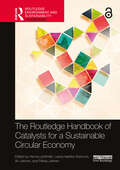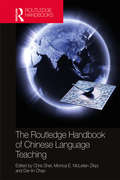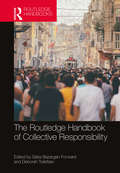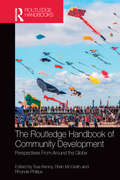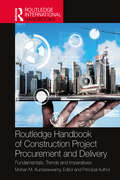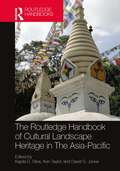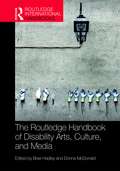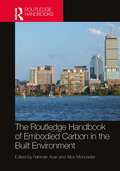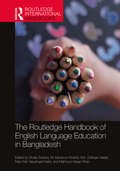- Table View
- List View
The Routledge Handbook of Catalysts for a Sustainable Circular Economy (Routledge Environment and Sustainability Handbooks)
This groundbreaking handbook leads the way in accelerating the transition to a sustainable circular economy by introducing the concept of a catalyst as a positive and enhancing driving force for sustainability. Catalysts create and maintain favourable conditions for complex systemic sustainability transition changes, and a discussion and understanding of catalysts is required to move from a linear economy to a sustainable and circular economy.With contributions from leading experts from around the globe, this volume presents theoretical insights, contextualised case studies, and participatory methodologies, which identify different catalysts, including technology, innovation, business models, management and organisation, regulation, sustainability policy, product design, and culture. The authors then show how these catalysts accelerate sustainability transitions. As a unique value to the reader, the book brings together public policy and private business perspectives to address the circular economy as a systemic change. Its theoretical and practical perspectives are coupled with real-world case studies from Finland, Italy, China, India, Nigeria, and others to provide tangible insights on catalysing the circular economy across organisational, hierarchical, and disciplinary boundaries.With its broad interdisciplinary and geographically diverse scope, this handbook will be a valuable tool for researchers, academics, and policy-makers in the fields of circular economy, sustainability transitions, environmental studies, business, and the social sciences more broadly.The Open Access version of this book, available at http://www.taylorfrancis.com, has been made available under a Creative Commons Attribution-Non Commercial-No Derivatives (CC-BY-NC-ND) 4.0 license.
Routledge Handbook of Chinese Architecture: Social Production of Buildings and Spaces in History
by Jianfei Zhu Chen Wei Li HuaThis handbook, representing the collaboration of 40 scholars, provides a multi-faceted exploration of roughly 6,000 years of Chinese architecture, from ancient times to the present. This volume combines a broad-spectrum approach with a thematic framework for investigating Chinese architecture, integrating previously fragmented topics and combining the scholarship of all major periods of Chinese history. By organizing its approach into five parts, this handbook: • Traces the practices and traditions of ancient China from imperial authority to folk culture.• Unveils a rich picture of early modern and republican China, revealing that modernization was already beginning to emerge.• Describes the social, intellectual, ideological, and formal enterprises of socialist architecture.• Frames a window on a complex and changing contemporary China by focusing on autonomy, state practices, and geopolitics of design, ultimately identifying its still evolving position on the world stage.• Examines the existing cultural and political theories to highlight potential avenues for future transformations in Chinese architecture that also retain Chinese identity. Providing a pioneering combination of ancient and modern Chinese architecture in one coherent study, this book is a must-read for scholars, students, and educators of Chinese architecture, architectural history and theory, and the architecture of Asia.
Routledge Handbook of Chinese Architecture: Social Production of Buildings and Spaces in History
by Jianfei Zhu Chen Wei Li HuaThis handbook, representing the collaboration of 40 scholars, provides a multi-faceted exploration of roughly 6,000 years of Chinese architecture, from ancient times to the present. This volume combines a broad-spectrum approach with a thematic framework for investigating Chinese architecture, integrating previously fragmented topics and combining the scholarship of all major periods of Chinese history. By organizing its approach into five parts, this handbook: • Traces the practices and traditions of ancient China from imperial authority to folk culture.• Unveils a rich picture of early modern and republican China, revealing that modernization was already beginning to emerge.• Describes the social, intellectual, ideological, and formal enterprises of socialist architecture.• Frames a window on a complex and changing contemporary China by focusing on autonomy, state practices, and geopolitics of design, ultimately identifying its still evolving position on the world stage.• Examines the existing cultural and political theories to highlight potential avenues for future transformations in Chinese architecture that also retain Chinese identity. Providing a pioneering combination of ancient and modern Chinese architecture in one coherent study, this book is a must-read for scholars, students, and educators of Chinese architecture, architectural history and theory, and the architecture of Asia.
The Routledge Handbook of Chinese Language Teaching
by Chris Shei Monica E McLellan Zikpi Der-Lin ChaoThe Routledge Handbook of Chinese Language Teaching defines Chinese language teaching in a pedagogical, historical, and contemporary context. Throughout the volume, teaching methods are discussed, including the traditional China-based approach, and Western methods such as communicative teaching and the immersion program. The Handbook also presents a pedagogical model covering pronunciation, tones, characters, vocabulary, grammar, and the teaching of listening, speaking, reading, and writing. The remaining chapters explore topics of language assessment, technology enhanced instruction, teaching materials and resources, Chinese for specific purposes, classroom implementation, social contexts of language teaching and language teaching policies, and pragmatics and culture. Ideal for scholars and researchers of Chinese language teaching, the Handbook will benefit educators and teacher training programs. This is the first comprehensive volume exploring the growing area of Chinese language pedagogy.
The Routledge Handbook of Chinese Language Teaching
by Chris Shei Monica E McLellan Zikpi Der-Lin ChaoThe Routledge Handbook of Chinese Language Teaching defines Chinese language teaching in a pedagogical, historical, and contemporary context. Throughout the volume, teaching methods are discussed, including the traditional China-based approach, and Western methods such as communicative teaching and the immersion program. The Handbook also presents a pedagogical model covering pronunciation, tones, characters, vocabulary, grammar, and the teaching of listening, speaking, reading, and writing. The remaining chapters explore topics of language assessment, technology enhanced instruction, teaching materials and resources, Chinese for specific purposes, classroom implementation, social contexts of language teaching and language teaching policies, and pragmatics and culture. Ideal for scholars and researchers of Chinese language teaching, the Handbook will benefit educators and teacher training programs. This is the first comprehensive volume exploring the growing area of Chinese language pedagogy.
Routledge Handbook of Collaboration in Construction
by Lauri Koskela Sina Moradi Kalle Kahkonen Ole Jonny Klakegg Kirsi AaltonenThis innovative Handbook aims to look at the logic, various dimensions, and implications of collaboration in construction. It opens with a conceptualization of collaboration and its accompanying terms (i.e., cooperation and coordination) and continues with chapters in Part I which discuss the theoretical grounds of collaboration between individuals and organizations from the viewpoints of an impressive variety of relevant disciplines including organizational science; anthropology; law; economics; design; and production.This is followed by discussions of the essence and value of collaboration in construction in Part II through explaining the role of collaborative project delivery methods and their benefits in advancing collaboration, describing the competency profile of project managers for collaborative construction, explaining key drivers and barriers of collaboration in construction, and explaining practices as well as challenges of measuring collaboration in construction.Then, in Part III, case projects are employed to explain the benefits of collaboration in different levels of team, project, and business, to discuss the role and impact of collaboration on site and bridging the divide between construction and facility management, to discuss the role of digitalization in facilitating and advancing collaboration, to explain collaboration in decision making, to present examples of collaborative visual management, and to outline the implications of stakeholders' early involvement and collaboration for project success. Finally, consideration is given to the future of collaboration in construction to conclude the book.This Handbook is key reading for a broad ranging audience within the fields of construction, project, infrastructure and engineering management, organisational science, economics, and business management.
Routledge Handbook of Collaboration in Construction
by Lauri Koskela Sina Moradi Ole Jonny Klakegg Kirsi Aaltonen Kalle KähkönenThis innovative Handbook aims to look at the logic, various dimensions, and implications of collaboration in construction. It opens with a conceptualization of collaboration and its accompanying terms (i.e., cooperation and coordination) and continues with chapters in Part I which discuss the theoretical grounds of collaboration between individuals and organizations from the viewpoints of an impressive variety of relevant disciplines including organizational science; anthropology; law; economics; design; and production.This is followed by discussions of the essence and value of collaboration in construction in Part II through explaining the role of collaborative project delivery methods and their benefits in advancing collaboration, describing the competency profile of project managers for collaborative construction, explaining key drivers and barriers of collaboration in construction, and explaining practices as well as challenges of measuring collaboration in construction.Then, in Part III, case projects are employed to explain the benefits of collaboration in different levels of team, project, and business, to discuss the role and impact of collaboration on site and bridging the divide between construction and facility management, to discuss the role of digitalization in facilitating and advancing collaboration, to explain collaboration in decision making, to present examples of collaborative visual management, and to outline the implications of stakeholders' early involvement and collaboration for project success. Finally, consideration is given to the future of collaboration in construction to conclude the book.This Handbook is key reading for a broad ranging audience within the fields of construction, project, infrastructure and engineering management, organisational science, economics, and business management.
The Routledge Handbook of Collective Responsibility (Routledge Handbooks in Philosophy)
by Bazargan-Forward, Saba / Tollefsen, DeborahThe Routledge Handbook of Collective Responsibility comprehensively addresses questions about who is responsible and how blame or praise should be attributed when human agents act together. Such questions include: Do individuals share responsibility for the outcome or are individuals responsible only for their contribution to the act? Are individuals responsible for actions done by their group even when they don’t contribute to the outcome? Can a corporation or institution be held morally responsible apart from the responsibility of its members? The Handbook’s 35 chapters—all appearing here for the first time and written by an international team of experts—are organized into four parts:Part I: Foundations of Collective ResponsibilityPart II: Theoretical Issues in Collective ResponsibilityPart III: Domains of Collective ResponsibilityPart IV: Applied Issues in Collective ResponsibilityEach part begins with a short introduction that provides an overview of issues and debates within that area and a brief summary of its chapters. In addition, a comprehensive index allows readers to better navigate the entirety of the volume’s contents. The result is the first major work in the field that serves as an instructional aid for those in advanced undergraduate courses and graduate seminars, as well as a reference for scholars interested in learning more about collective responsibility.
The Routledge Handbook of Collective Responsibility (Routledge Handbooks in Philosophy)
by Saba Bazargan-Forward Deborah TollefsenThe Routledge Handbook of Collective Responsibility comprehensively addresses questions about who is responsible and how blame or praise should be attributed when human agents act together. Such questions include: Do individuals share responsibility for the outcome or are individuals responsible only for their contribution to the act? Are individuals responsible for actions done by their group even when they don’t contribute to the outcome? Can a corporation or institution be held morally responsible apart from the responsibility of its members? The Handbook’s 35 chapters—all appearing here for the first time and written by an international team of experts—are organized into four parts:Part I: Foundations of Collective ResponsibilityPart II: Theoretical Issues in Collective ResponsibilityPart III: Domains of Collective ResponsibilityPart IV: Applied Issues in Collective ResponsibilityEach part begins with a short introduction that provides an overview of issues and debates within that area and a brief summary of its chapters. In addition, a comprehensive index allows readers to better navigate the entirety of the volume’s contents. The result is the first major work in the field that serves as an instructional aid for those in advanced undergraduate courses and graduate seminars, as well as a reference for scholars interested in learning more about collective responsibility.
The Routledge Handbook of Community Development: Perspectives from Around the Globe
by Sue Kenny Brian McGrath Rhonda PhillipsThe Routledge Handbook of Community Development explores community development theory and practice across the world. The book provides perspectives about community development as an interactive, relevant and sometimes contradictory way to address issues impacting the human condition. It promotes better understanding of the complexities and challenges in identifying, designing, implementing and evaluating community development constructs, applications and interventions. This edited volume discusses how community development is conceptualized as an approach, method or profession. Themes provide the scope of the book, with projects, issues or perspectives presented in each of these areas. This handbook provides invaluable contextualized insights on the theory and practice of community development around core themes relevant in society. Each chapter explores and presents an issue, perspectives, project or case in the thematic areas, with regional and country context included. It is a must-read for students and researchers working in community development, planning and human geography and an essential reference for any professional engaged in community development.
The Routledge Handbook of Community Development: Perspectives from Around the Globe
by Rhonda Phillips Sue Kenny Brian McGrathThe Routledge Handbook of Community Development explores community development theory and practice across the world. The book provides perspectives about community development as an interactive, relevant and sometimes contradictory way to address issues impacting the human condition. It promotes better understanding of the complexities and challenges in identifying, designing, implementing and evaluating community development constructs, applications and interventions. This edited volume discusses how community development is conceptualized as an approach, method or profession. Themes provide the scope of the book, with projects, issues or perspectives presented in each of these areas. This handbook provides invaluable contextualized insights on the theory and practice of community development around core themes relevant in society. Each chapter explores and presents an issue, perspectives, project or case in the thematic areas, with regional and country context included. It is a must-read for students and researchers working in community development, planning and human geography and an essential reference for any professional engaged in community development.
Routledge Handbook of Construction Project Procurement and Delivery: Fundamentals, Trends and Imperatives
by Mohan M. KumaraswamyThis Handbook provides the knowledge needed to design and deploy proactive construction project procurement and delivery systems based on essentials while addressing emerging construction industry imperatives in order to boost overall performance.Section 1 of the Handbook provides an overview, while Section 2 provides the fundamentals with fresh insights into the building blocks and trends in performance-linked procurement and delivery, including procurement strategies and commercial priorities, project briefs and management plans, design management, stakeholder management, risk management, ethics and professionalism, team building, information and knowledge management, digital aids, conflict, claims and dispute management, collaborative contracting, relationship-based teamworking and linking to built asset management.Section 3 explores and expands on specific trends, including sub-contractor selection, Building Information Modelling (BIM) in project cost management; off-site and modern methods of construction; 4IR/5IR technologies; and constructing for the circular economy, supply chain resilience and social value imperatives in this domain.While other books describe standard processes or focus on specific strategies such as design and build, target cost contracting or integrated project delivery, this Handbook presents the fundamentals of such processes and protocols together with invited specialist insights into growing trends and imperatives in holistic procurement and delivery. Those who could benefit from this Handbook include academics, researchers, postgraduate students, policy makers and administrators, managers in both public and private sectors involved with planning and overseeing construction project procurement and/or delivery and undergraduates looking for a balanced introduction and useful insights into what is critical to the success of construction projects, organisations and the industry itself.
Routledge Handbook of Construction Project Procurement and Delivery: Fundamentals, Trends and Imperatives
This Handbook provides the knowledge needed to design and deploy proactive construction project procurement and delivery systems based on essentials while addressing emerging construction industry imperatives in order to boost overall performance.Section 1 of the Handbook provides an overview, while Section 2 provides the fundamentals with fresh insights into the building blocks and trends in performance-linked procurement and delivery, including procurement strategies and commercial priorities, project briefs and management plans, design management, stakeholder management, risk management, ethics and professionalism, team building, information and knowledge management, digital aids, conflict, claims and dispute management, collaborative contracting, relationship-based teamworking and linking to built asset management.Section 3 explores and expands on specific trends, including sub-contractor selection, Building Information Modelling (BIM) in project cost management; off-site and modern methods of construction; 4IR/5IR technologies; and constructing for the circular economy, supply chain resilience and social value imperatives in this domain.While other books describe standard processes or focus on specific strategies such as design and build, target cost contracting or integrated project delivery, this Handbook presents the fundamentals of such processes and protocols together with invited specialist insights into growing trends and imperatives in holistic procurement and delivery. Those who could benefit from this Handbook include academics, researchers, postgraduate students, policy makers and administrators, managers in both public and private sectors involved with planning and overseeing construction project procurement and/or delivery and undergraduates looking for a balanced introduction and useful insights into what is critical to the success of construction projects, organisations and the industry itself.
The Routledge Handbook of Contemporary Art in Global Asia
by Menene Gras Jonathan Harris Bashir MakhoulThis substantial collection of newly commissioned essays presents an ambitious, entertaining, and accessible guide to developments in Asian art over the past 20 years of the epoch of globalization. The term ‘global Asia’ signals the genesis and evolution of contemporary art within the context of global economic, social, political, and intellectual change related to the end of the Cold War, decolonization, the emergence of postcolonial societies and cultures, and the rise of a global contemporary art world. In the handbook its editors establish, in an extended introductory section and in four section introductions, the theoretical, geographical, and historical parameters within which the contemporary visual arts of ‘global Asia’ may be described, analyzed, and evaluated. The collected chapters provide a diverse, multiauthored, heterogeneous, and genuinely plural account of art and its contexts. The democratic and inclusive character of globalization is reflected and produced within this anthology, which includes different styles of writing as well as varieties of analytic and thematic focus. The anthology will appeal to both scholars and students in art history, art practice, curation, contemporary art, fine art, cultural studies, and globalization studies.
The Routledge Handbook of Contemporary Art in Global Asia (Routledge Art History And Visual Studies Companions Ser.)
by Menene Gras Jonathan Harris Bashir MakhoulThis substantial collection of newly commissioned essays presents an ambitious, entertaining, and accessible guide to developments in Asian art over the past 20 years of the epoch of globalization. The term ‘global Asia’ signals the genesis and evolution of contemporary art within the context of global economic, social, political, and intellectual change related to the end of the Cold War, decolonization, the emergence of postcolonial societies and cultures, and the rise of a global contemporary art world. In the handbook its editors establish, in an extended introductory section and in four section introductions, the theoretical, geographical, and historical parameters within which the contemporary visual arts of ‘global Asia’ may be described, analyzed, and evaluated. The collected chapters provide a diverse, multiauthored, heterogeneous, and genuinely plural account of art and its contexts. The democratic and inclusive character of globalization is reflected and produced within this anthology, which includes different styles of writing as well as varieties of analytic and thematic focus. The anthology will appeal to both scholars and students in art history, art practice, curation, contemporary art, fine art, cultural studies, and globalization studies.
The Routledge Handbook of Cultural Landscape Heritage in The Asia-Pacific (Routledge Handbooks on Museums, Galleries and Heritage)
by Kapila D. Silva Ken Taylor David S. JonesThe Routledge Handbook of Cultural Landscape Heritage in the Asia-Pacific revisits the use, growth, and potential of the cultural landscape methodology in the conservation and management of culture-nature heritage in the Asia-Pacific region. Taking both a retrospective and prospective view of the management of cultural heritage in the region, this volume argues that the plurality and complexity of heritage in the region cannot be comprehensively understood and effectively managed without a broader conceptual framework like the cultural landscape approach. The book also demonstrates that such an approach facilitates the development of a flexible strategy for heritage conservation. Acknowledging the effects of rapid socio-economic development, globalization, and climate change, contributors examine the pressure these issues place on the sustenance of cultural heritage. Including chapters from more than 20 countries across the Asia-Pacific region, the volume reviews the effectiveness of theoretical and practical potentials afforded by the cultural landscape approach and examines how they have been utilized in the Asia-Pacific context for the last three decades. The Routledge Handbook of Cultural Landscape Heritage in the Asia-Pacific provides a comprehensive analysis of the processes of cultural landscape heritage conservation and management. As a result, it will be of interest to academics, students, and professionals who are based in the fields of cultural heritage management, architecture, urban planning, landscape architecture, and landscape management.
The Routledge Handbook of Cultural Landscape Heritage in The Asia-Pacific (Routledge Handbooks on Museums, Galleries and Heritage)
by Ken Taylor David S. Jones Kapila D. SilvaThe Routledge Handbook of Cultural Landscape Heritage in the Asia-Pacific revisits the use, growth, and potential of the cultural landscape methodology in the conservation and management of culture-nature heritage in the Asia-Pacific region. Taking both a retrospective and prospective view of the management of cultural heritage in the region, this volume argues that the plurality and complexity of heritage in the region cannot be comprehensively understood and effectively managed without a broader conceptual framework like the cultural landscape approach. The book also demonstrates that such an approach facilitates the development of a flexible strategy for heritage conservation. Acknowledging the effects of rapid socio-economic development, globalization, and climate change, contributors examine the pressure these issues place on the sustenance of cultural heritage. Including chapters from more than 20 countries across the Asia-Pacific region, the volume reviews the effectiveness of theoretical and practical potentials afforded by the cultural landscape approach and examines how they have been utilized in the Asia-Pacific context for the last three decades. The Routledge Handbook of Cultural Landscape Heritage in the Asia-Pacific provides a comprehensive analysis of the processes of cultural landscape heritage conservation and management. As a result, it will be of interest to academics, students, and professionals who are based in the fields of cultural heritage management, architecture, urban planning, landscape architecture, and landscape management.
Routledge Handbook of Cultural Landscape Practice (Routledge International Handbooks)
by Steve Brown Cari GoetcheusCultural landscapes, which in the field of heritage studies and practice relates to caring for and safeguarding heritage landscapes, is a concept embedded in contemporary conservation. Heritage conservation has shifted from an historical focus on buildings, city centres, and archaeological sites to encompass progressively more diverse forms of heritage and increasingly larger geographic areas, embracing both rural and urban landscapes. While the origin of the idea of cultural landscapes can be traced to the late-19th century Euro-American scholarship, it came to global attention after 1992 following its adoption as a category of ‘site’ by the UNESCO World Heritage Committee. Today, cultural landscape practice has become increasingly complex given the expansion of the values and meanings of heritage, the influence of environmental challenges such as human induced climate change, technological advancements, and the need to better understand and interpret human connections to place and landscapes. The aim of this handbook is to strike a balance between theory and practice, which we see as inseparable, while also seeking to achieve a geographical spread, disciplinary diversity and perspectives, and a mix of authors from academic, practitioner, management, and community backgrounds.
Routledge Handbook of Cultural Landscape Practice (Routledge International Handbooks)
by Steve Brown Cari GoetcheusCultural landscapes, which in the field of heritage studies and practice relates to caring for and safeguarding heritage landscapes, is a concept embedded in contemporary conservation. Heritage conservation has shifted from an historical focus on buildings, city centres, and archaeological sites to encompass progressively more diverse forms of heritage and increasingly larger geographic areas, embracing both rural and urban landscapes. While the origin of the idea of cultural landscapes can be traced to the late-19th century Euro-American scholarship, it came to global attention after 1992 following its adoption as a category of ‘site’ by the UNESCO World Heritage Committee. Today, cultural landscape practice has become increasingly complex given the expansion of the values and meanings of heritage, the influence of environmental challenges such as human induced climate change, technological advancements, and the need to better understand and interpret human connections to place and landscapes. The aim of this handbook is to strike a balance between theory and practice, which we see as inseparable, while also seeking to achieve a geographical spread, disciplinary diversity and perspectives, and a mix of authors from academic, practitioner, management, and community backgrounds.
The Routledge Handbook of Disability Arts, Culture, and Media
by Bree Hadley Donna McDonaldIn the last 30 years, a distinctive intersection between disability studies – including disability rights advocacy, disability rights activism, and disability law – and disability arts, culture, and media studies has developed. The two fields have worked in tandem to offer critique of representations of disability in dominant cultural systems, institutions, discourses, and architecture, and develop provocative new representations of what it means to be disabled. Divided into 5 sections: Disability, Identity, and Representation Inclusion, Wellbeing, and Whole-of-life Experience Access, Artistry, and Audiences Practices, Politics and the Public Sphere Activism, Adaptation, and Alternative Futures this handbook brings disability arts, disability culture, and disability media studies – traditionally treated separately in publications in the field to date – together for the first time. It provides scholars, graduate students, upper level undergraduate students, and others interested in the disability rights agenda with a broad-based, practical and accessible introduction to key debates in the field of disability art, culture, and media studies. An internationally recognised selection of authors from around the world come together to articulate the theories, issues, interests, and practices that have come to define the field. Most critically, this book includes commentaries that forecast the pressing present and future concerns for the field as scholars, advocates, activists, and artists work to make a more inclusive society a reality.
The Routledge Handbook of Disability Arts, Culture, and Media
In the last 30 years, a distinctive intersection between disability studies – including disability rights advocacy, disability rights activism, and disability law – and disability arts, culture, and media studies has developed. The two fields have worked in tandem to offer critique of representations of disability in dominant cultural systems, institutions, discourses, and architecture, and develop provocative new representations of what it means to be disabled. Divided into 5 sections: Disability, Identity, and Representation Inclusion, Wellbeing, and Whole-of-life Experience Access, Artistry, and Audiences Practices, Politics and the Public Sphere Activism, Adaptation, and Alternative Futures this handbook brings disability arts, disability culture, and disability media studies – traditionally treated separately in publications in the field to date – together for the first time. It provides scholars, graduate students, upper level undergraduate students, and others interested in the disability rights agenda with a broad-based, practical and accessible introduction to key debates in the field of disability art, culture, and media studies. An internationally recognised selection of authors from around the world come together to articulate the theories, issues, interests, and practices that have come to define the field. Most critically, this book includes commentaries that forecast the pressing present and future concerns for the field as scholars, advocates, activists, and artists work to make a more inclusive society a reality.
The Routledge Handbook of Embodied Carbon in the Built Environment
by Rahman Azari Alice MoncasterThis handbook explores the critically important topic of embodied carbon, providing advanced insights that focus on measuring and reducing embodied carbon from across the built environment, including buildings, urban areas and cities, and construction materials and components. Split into five distinct sections, international experts, researchers, and professionals present the recent developments in the field of embodied carbon from various perspectives and at different scales of material, building, and city. Following an introduction to the embodied carbon question, the chapters in Section 1 then cover the key debates around issues such as the politics of embodied carbon, links between embodied carbon and thermal mass, and the misuse of carbon offsets. Section 2 reviews the embodied carbon policies in a selected number of countries. Sections 3, 4, and 5 approach the topic of embodied carbon from urban-, building-, and material-scale perspectives, respectively, and use case studies to demonstrate estimation techniques and present opportunities and challenges in embodied carbon mitigation. This will be important reading for upper-level students and researchers in Architecture, Urban Planning, Engineering, and Construction disciplines. Presenting case studies of embodied carbon assessment, this book will also help practicing architects, engineers, and urban planners understand embodied carbon estimation techniques and different mitigation strategies.
The Routledge Handbook of Embodied Carbon in the Built Environment
This handbook explores the critically important topic of embodied carbon, providing advanced insights that focus on measuring and reducing embodied carbon from across the built environment, including buildings, urban areas and cities, and construction materials and components. Split into five distinct sections, international experts, researchers, and professionals present the recent developments in the field of embodied carbon from various perspectives and at different scales of material, building, and city. Following an introduction to the embodied carbon question, the chapters in Section 1 then cover the key debates around issues such as the politics of embodied carbon, links between embodied carbon and thermal mass, and the misuse of carbon offsets. Section 2 reviews the embodied carbon policies in a selected number of countries. Sections 3, 4, and 5 approach the topic of embodied carbon from urban-, building-, and material-scale perspectives, respectively, and use case studies to demonstrate estimation techniques and present opportunities and challenges in embodied carbon mitigation. This will be important reading for upper-level students and researchers in Architecture, Urban Planning, Engineering, and Construction disciplines. Presenting case studies of embodied carbon assessment, this book will also help practicing architects, engineers, and urban planners understand embodied carbon estimation techniques and different mitigation strategies.
The Routledge Handbook of English Language Education in Bangladesh (Routledge International Handbooks of Education)
by Shaila Sultana M. Moninoor Roshid Md. Zulfeqar Haider Mian Md. Naushaad Kabir Mahmud Hasan KhanThis Handbook is a comprehensive overview of English language education in Bangladesh. Presenting descriptive, theoretical, and empirical chapters as well as case studies, this Handbook, on the one hand, provides a comprehensive view of the English language teaching and learning scenario in Bangladesh, and on the other hand comes up with suggestions for possible decolonisation and de-eliticisation of English in Bangladesh. The Handbook explores a wide range of diverse endogenous and exogenous topics, all related to English language teaching and learning in Bangladesh, and acquaints readers with different perspectives, operating from the macro to the micro levels. The theoretical frameworks used are drawn from applied linguistics, education, sociology, political science, critical geography, cultural studies, psychology, and economics. The chapters examine how much generalisability the theories have for the context of Bangladesh and how the empirical data can be interpreted through different theoretical lenses. There are six sections in the Handbook covering different dynamics of English language education practices in Bangladesh, from history, policy and practice to assessment, pedagogy and identity. It is an invaluable reference source for students, researchers, and policy makers interested in English language, ELT, TESOL, and applied linguistics.
The Routledge Handbook of English Language Education in Bangladesh (Routledge International Handbooks of Education)
by Shaila Sultana M. Moninoor Roshid Zulfeqar Haider Mian Naushaad Kabir Mahmud Hasan KhanThis Handbook is a comprehensive overview of English language education in Bangladesh. Presenting descriptive, theoretical, and empirical chapters as well as case studies, this Handbook, on the one hand, provides a comprehensive view of the English language teaching and learning scenario in Bangladesh, and on the other hand comes up with suggestions for possible decolonisation and de-eliticisation of English in Bangladesh. The Handbook explores a wide range of diverse endogenous and exogenous topics, all related to English language teaching and learning in Bangladesh, and acquaints readers with different perspectives, operating from the macro to the micro levels. The theoretical frameworks used are drawn from applied linguistics, education, sociology, political science, critical geography, cultural studies, psychology, and economics. The chapters examine how much generalisability the theories have for the context of Bangladesh and how the empirical data can be interpreted through different theoretical lenses. There are six sections in the Handbook covering different dynamics of English language education practices in Bangladesh, from history, policy and practice to assessment, pedagogy and identity. It is an invaluable reference source for students, researchers, and policy makers interested in English language, ELT, TESOL, and applied linguistics.
